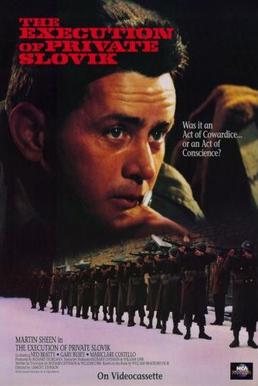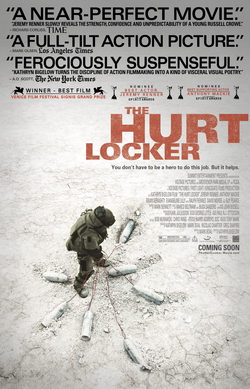“The Execution of Private
Slovik” has been one of my great white whales for some time now. (Another is
“Ice Cold in Alex”.) I finally was able
to watch it again after having seen it forty-two years ago when it appeared on
NBC as a made-for-TV special. The movie
was based on a nonfiction book by William Bradford Huie published in 1954. It was directed by Lamont Johnson. He was nominated for an Emmy, as was the
movie. The movie won two Emmys for
editing. It also won a Peabody
Award. Originally, the movie was
supposed to be made by Frank Sinatra, who was interested in the story. However, Sinatra wanted to use a screenplay
by Albert Maltz, but that was during the Cold War and Maltz had been
black-listed as one of the Hollywood Ten.
Sinatra was accused of being a Communist sympathizer and the Kennedy
campaign put pressure on him to drop the project.
The movie opens in January, 1945
in France. The execution is being
prepared. A member of the firing squad
mentions that no American has been executed for desertion yet. The consensus among the twelve men is Slovik
(Martin Sheen) has it coming to him. No one is thrilled to be part of the detail. A
chaplain named Father Stafford (Ned Beatty) bucks them up by proclaiming that
“a higher authority has accepted moral responsibility”. Do your duty.
When one soldier proposes purposely missing, another says “I’m not going
to miss… He didn’t care about how many of us got shot up, so I’m not going to
care about him.”
The movie now flashes back to
how Slovik got to this point. The narrative
takes the form of characters reminiscing about Eddie. Starting with the warden of the prison Eddie
is being paroled from for theft. The
warden makes a point of stating that he could have predicted that the “sweet
kid” would freeze or run the first time he was in combat. Slovik gets a job and courts the bookkeeper
of his employer. They get married and
are living happily, if poorly, with the comforting knowledge that as an ex-con
he is designated 4-F and thus not draftable.
This changes on their first anniversary when they find out he has been
reclassified 1-A. “Greetings” is not far
away. It’s off to boot camp where Eddie
is a sad sack, but good enough to be a replacement. On his way to the front, he and his buddy
Jimmy (Gary Busey) take refuge from a bombardment and it’s a turning point for
him because he vows never to go through that again. Maybe he won’t have to as the two stragglers
end up with a Canadian rear unit for a few idyllic weeks. However, all good things must come to an end
as Eddie and Jimmy are eventually returned to their unit. Eddie is up-front about his cowardice with
his commanding officer and when the Captain is not sympathetic, Eddie flees. The rest is history.
“The Execution of Private
Slovik” is like a well-acted docudrama.
I refer to it being semi-documentary because it is awesomely
accurate. You do not need to read Huie’s
book. There are no significant
enhancements of the real story. It shows
you how entertaining the tale is even without enhancement. But it’s not just the fact that you learn
exactly what happened in the most famous case of military justice involving an
American soldier in WWII. It is more
importantly a movie that helps right a wrong.
There is no doubt that the execution was an egregious injustice that
taints the reputations of Gen. Norman Cota (commander of the 28th
Division) and Gen. Eisenhower. Both of
whom refused to commute the sentence. There were 21,000 convictions for
desertion of American soldiers during the war.
This was the only one of 49 death penalties for desertion that was not
commuted! It was the only execution by
the U.S. military that was not for rape and/or murder of a civilian. (There were 102 of those executions.) Slovik was the proverbial example that was
made because morale was shaky at this point in the war and the upcoming assault
on Heurtgen Forest was going to be a rough one.
Slovik had incredibly bad timing for his confession.
The movie is very competently
made for a movie that had a budget of less than a million dollars. The cast is minor with the only stars being
Sheen and Beatty. Sheen is outstanding
and was nominated for an Emmy. He nails
the petty thief who is getting his life together when he is thrust into a
situation he could not handle.
Surprisingly, the cinematography is noteworthy. There is an intriguing mixture of high and
low shots and some far shots. Not what
you would expect from a made-for-TV movie.
The plot is not melodramatic. It
is a bit simplistic, but I have already mentioned that it is true to the story. The nonlinear structure works and the
decision to tell the story partly through narration by different people was a
good one. The movie does a great job as
a tutorial on how a court-martial and execution worked in WWII. It gets all the little details right. For example, if the condemned was not able to
stand on his own, they would be strapped to what was called a “collapse board”.
“The Execution of Private
Slovik” was well worth the wait. It is a
must-see for not only war movie lovers, but fans of American History. It is one of the most accurate war movies I
have seen. It is an important movie as
it brings a travesty to the public. To
most, even knowledgeable Americans, Slovik was a trivia answer. Who was the only American soldier executed
for desertion in WWII? You would have to
assume that he must have done something incredibly cowardly that cost the lives
of other Americans. In 1987, President
Reagan was persuaded to allow Eddie Slovik’s body to be exhumed and reburied
next to his wife. Maybe as an ex-actor,
he was influenced by the movie. I would
like to think so.
GRADE
= A-



_01.png)